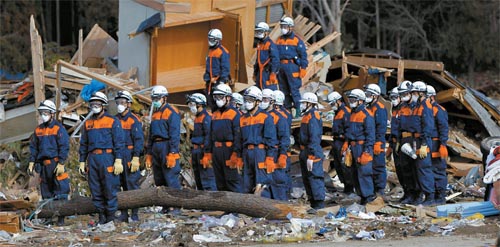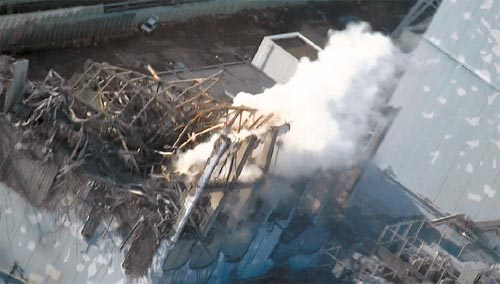Frantic cooling efforts continue

Rescue workers observe a minute of silence to mourn the victims of the quake and tsunami in Rikuzentakata, Iwate Prefecture, yesterday. [REUTERS/YONHAP]
A week after a massive earthquake and tsunami crippled a nuclear power plant, the future of Japan hinges on tens of water cannon trucks being used to cool the reactors at Fukushima Daiichi Nuclear Power Station and avert a catastrophic meltdown.
Roughly 50 tons of highly pressurized water was sprayed from water trucks by the Japan Self-Defense Forces and the Tokyo Fire Department from around 2 p.m. yesterday. A fire truck lent from the U.S. military was also used.
Japanese officials said that the plant’s No. 3 reactor was the “most critical,” as the water in a pool containing spent fuel rods had nearly evaporated, exposing the radioactive rods to the air.
The reactor emitted white vapor after the trucks shot water onto it, signaling that the water had hit its target.
The operation followed a similar one on Thursday, when military helicopters were deployed to dump tons of water on the reactors, which was less-effective than hoped for. Japan’s defense minister said the helicopters would not be used yesterday. Water cannon trucks were used late on Thursday afternoon, and radiation levels were found to have receded afterward.

In this photo released by Tokyo Electric Power Co. (Tepco), thick white vapor billows from the No. 3 unit of the Fukushima Daiichi nuclear power plant in Okuma-machi, Fukushima Prefecture, Thursday afternoon. [AP/YONHAP]
Japan’s nuclear agency spokesman Hidehiko Nishiyama said it was unclear how effective spraying water on the reactors from helicopters had been on Thursday, but the priority now was to get water into the spent-fuel pools.
“We have to reduce the heat somehow and may use seawater,” he told a news conference. “We need to get the reactors back online as soon as possible and that’s why we’re trying to restore power to them.”
Officials said they hoped to fix a power cable to at least two of the six reactors in the hope of restarting water pumps.
However, no one was holding out hope that the crisis - about to enter its second week after last Friday’s 9.0-magnitude earthquake and tsunami - could be overcome anytime soon.
The United States’ top nuclear regulator said it could take weeks to reverse the overheating of fuel rods at the Fukushima Daiichi plant.
“This is something that will take some time to work through, possibly weeks, as you eventually remove the majority of the heat from the reactors and then the spent-fuel pools,” Nuclear Regulatory Commission Chairman Gregory Jaczko told a news conference at the White House.
Jaczko said the cooling pool for spent fuel rods at the complex’s reactor No. 4 may have run dry.
Japan’s nuclear agency spokesman conceded that a “Chernobyl solution” of burying the reactors in sand and concrete was in the back of authorities’ minds.
Yukiya Amano, head of the Vienna-based International Atomic Energy Agency (IAEA), returned to his home country yesterday with an international team of experts, who deemed the succession of explosions and fires at the Fukushima Daiichi nuclear power plant as “serious.”
“We see it as an extremely serious accident,’’ Amano told reporters Friday upon landing in Narita International Airport in Tokyo. “This is not something that just Japan should deal with, and people of the entire world should cooperate with Japan and the people in the disaster areas.’’
With his team, Amano will be inspecting the levels of radiation around the nuclear plant, including atmospheric levels.
Chief Cabinet Secretary Yukio Edano said during a press briefing yesterday that radiation levels at several points at the plant were higher than normal but not dangerous to the human body.
Later, Japanese Prime Minister Naoto Kan promised that the government would disclose information on the accidents at the Fukushima Daiichi power plant in a “transparent” manner during a meeting with the IAEA chief. The official death toll from the disasters stood at 6,405 as of yesterday morning, with 10,259 missing.
Reuters
By Christine Kim [christine.kim@joongang.co.kr]
Related Korean Article[중앙일보]
‘하이퍼레스큐’ 139명 심야 살수 작전
후쿠시마 원전 방사능 수치
살수 작업한 17일부터 떨어져
1·2호기 전력 연결작업 진전
미, 핵 특수부대 450명 파견
대지진과 쓰나미(지진해일)로 파손된 일본 후쿠시마(福島) 제1원자력발전소의 방사성 물질 유출을 막기 위한 사투가 계속되고 있다.
도쿄소방청의 정예 ‘하이퍼 레스큐(Hyper Rescue)’ 대원 139명은 제1원전 3호기 냉각을 위해 심야인 19일 0시30분 고성능 소방차로 물을 뿌렸다. 자위대도 전날에 이어 18일 7대의 특수 소방차로 3호기에 물을 뿌렸다.
냉각작업과 별개로 원전 운영사인 도쿄전력은 이날 320명의 인력을 동원해 도호쿠(東北)전력의 송전선을 끌어와 제1원전 배전반((配電盤)에 연결하는 작업에 돌입했다. 외벽 피해가 적은 1·2호기에 접속해 전원을 복구하면 긴급 노심 냉각장치를 가동해 냉각수를 공급할 방침이다. 3·4호 원자로에도 20일 전력을 연결할 계획이다. 그러나 원자로에 냉각수를 공급하는 장치가 쓰나미와 원자로 폭발로 훼손됐을 수 있어 정상 가동될지는 불투명하다.
원자로 주변 방사능 수치는 살수작업이 시작된 17일 이후 낮아졌다. 2호기 서쪽 약 1㎞ 지점의 시간당 방사능 수치는 17일 오전 0시 351.4μSv(마이크로시버트)에서 18일 오후 1시 262.0μSv로 낮아졌다.
간 나오토(菅直人) 일본 총리는 18일 도쿄에 도착한 아마노 유키야 국제원자력기구(IAEA) 사무총장을 만나 투명한 정보 공개를 약속했다. 일본은 후쿠시마 원전 사고의 국제원자력사고등급(INES)을 4등급(방사성 물질 해당 지역 유출)에서 5등급(방사성 물질 제한적 외부 유출)으로 올렸다. 미국은 18일 일본의 요청에 따라 핵 전문인력 450명을 파견할 준비를 하고 있다. 로버트 윌러드 미 태평양군사령관은 “미국은 일본의 원전 사태 수습을 조심스럽게 낙관하는 입장”이라고 말했다.










with the Korea JoongAng Daily
To write comments, please log in to one of the accounts.
Standards Board Policy (0/250자)